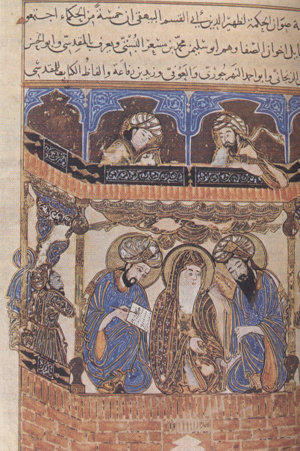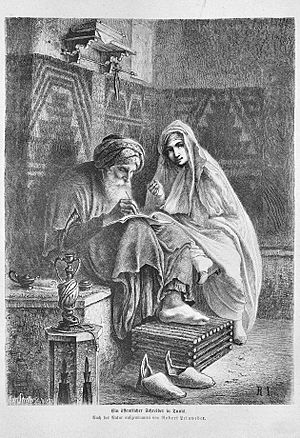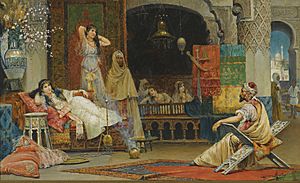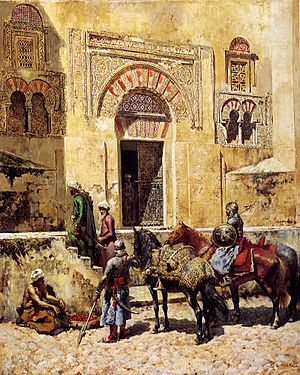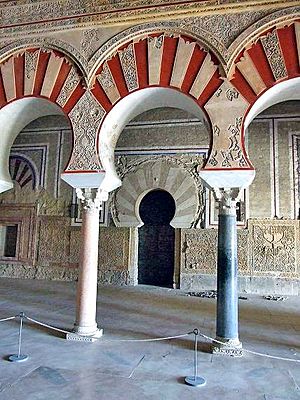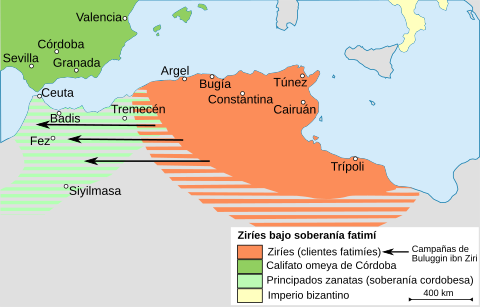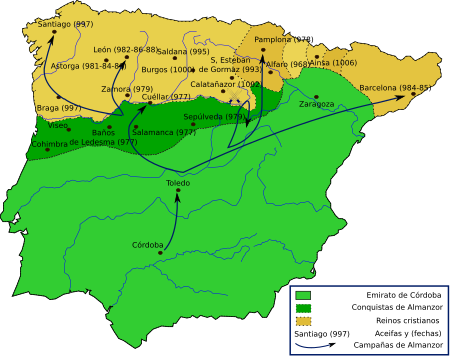Almanzor facts for kids
Quick facts for kids Muḥammad ibn ʿAbdullāh ibn Abi ʿĀmir al-Maʿafiri |
|
|---|---|

|
|
| Successor | Abd al-Malik al-Muzaffar |
| Born | c. 938 Torrox, Axarquía |
| Died | 1002 |
| Burial | Medinaceli, Spain |
| House | Amirids |
| Religion | Sunni Islam |
Almanzor (born around 938 – died August 8, 1002) was a very powerful Muslim leader and general in Al-Andalus (Islamic Spain). His full name was Abu ʿĀmir Muḥammad ibn ʿAbdullāh ibn Abi ʿĀmir al-Maʿafiri. People called him al-Manṣūr, which means "the Victorious."
Almanzor was like a prime minister or chief advisor for the young Caliph Hisham II. But in reality, Almanzor held almost all the power. He was the true ruler of Islamic Spain for many years.
He was born in a small village near Torrox to a family with a background in law. Almanzor moved to Córdoba when he was young to study law. After starting with small jobs, he quickly joined the court. He gained the trust of Subh, the mother of Caliph Al-Hakam II's children. With her help and his own skills, he became very important.
During Caliph Al-Hakam II's rule, Almanzor held many key jobs. These included managing the royal mint and looking after the Caliph's children. When the Caliph died in 976, Almanzor's power grew even more. He became the chamberlain (a top official) in 978. He had huge power across the Iberian Peninsula and parts of North Africa. Caliph Hisham II became more of a figurehead, meaning he had the title but not the real power.
Almanzor was very ambitious and wanted to be in charge. He was also very religious. Muslim leaders supported him because he defended their faith. He often led military campaigns, which he called jihad (holy war). This helped him gain more power and justify his rule.
Almanzor made big changes in how the government worked, both at home and with other countries. He led many successful military campaigns in North Africa and Spain. In Spain, his attacks on the Christian kingdoms stopped their advance for a while.
Contents
Early Life and Family
Almanzor was born around 939. His family was Arab and owned land. They had lived in Torrox since the Muslim conquest of Spain. His ancestors were rewarded with land for their bravery in battle.
Some of his family members were judges and legal experts. His grandfather became a judge in Seville. His father, Abd Allah, was known as a kind and religious man. He died while returning from a pilgrimage to Mecca. Almanzor's mother, Burayha, also came from an Arab family. Even so, his family was considered middle class.
Rising in the Royal Court
Almanzor moved to Córdoba when he was young. He studied law and literature. This training was meant to help him join the government. He learned about the Quran, religious traditions, and Islamic law. He wanted to become a judge.
After his father died, his family faced money problems. Almanzor had to become a scrivener (a scribe or writer). He worked near the royal palace and the Great Mosque of Córdoba. He quickly showed his talent and ambition. He started his political career as a clerk for the chief judge of Córdoba. This judge was an important advisor to Caliph Al-Hakam II.
Almanzor soon caught the eye of Vizier Ja'far al-Mushafi, who was in charge of the government. He helped Almanzor get into the royal court. Almanzor was known for his knowledge and skill. He began to get more and more important jobs. He was in his thirties and part of a new group of young officials.
In 967, Almanzor was put in charge of Abd al-Rahman, the son of Caliph Al-Hakam II and his favorite, Subh. Subh was a very smart woman who had a lot of influence over the Caliph. Almanzor formed a special bond with her, which greatly helped his career.
He managed the estates of the young prince and his mother. This gave him close access to the royal family. He quickly gained more important positions. Seven months later, he became the director of the royal mint. In 968, he became the treasurer for unclaimed inheritances. The next year, he was made a judge in important cities like Seville. When Prince Abd al-Rahman died in 970, Almanzor took on the same role for the new young heir, Hisham.
By this time, he had married the sister of the head of the Caliph's guard. He started to become very wealthy. He built a grand home and gave expensive gifts to the Caliph's family. He was accused of misusing money from the mint in 972. But he was helped to cover the missing funds. He kept his other important jobs.
In 973, he handled the planning and diplomacy for a campaign in North Africa. He was the chief judge for the Umayyad lands there. This job gave him power over both civilians and soldiers. He had to get local leaders to accept the Caliph's rule by giving them gifts. This helped weaken the enemy.
Almanzor returned to Córdoba in 974 after a successful campaign. His ability to manage the campaign's organization and money was praised. He was again put in charge of the mint. In the last months of Al-Hakam's illness, Almanzor was made inspector of the professional troops. These troops were mainly Berbers from North Africa. This gave him access to the young prince Hisham, who was next in line for the throne.
Taking Power
Becoming a Triumvirate
When Caliph Al-Hakam II died on October 1, 976, his son Hisham became Caliph. This was a big moment for Almanzor. Hisham was only about 11 years old, too young to rule. This was unusual for the Caliphate. Some people wanted a regent (someone to rule for the young Caliph). Others wanted to make Al-Hakam's brother, al-Mughira, the new Caliph.
Two important court officials tried to put al-Mughira on the throne. But the chief minister, al-Mushafi, stopped their plan. He had the support of Subh and Berber troops. He told Almanzor to kill al-Mughira. Almanzor did so, even though he didn't want to.
Hisham II became Caliph on October 1, 976. Almanzor was part of the ceremony. A week later, Hisham named al-Mushafi as his hajib (prime minister). Almanzor, then 36, was made a vizier (minister) and al-Mushafi's delegate. This made Almanzor a key link between the young Caliph's mother (Subh) and the government. Power was shared by three people: al-Mushafi, Almanzor, and General Ghalib. To make the new Caliph popular, they removed an unpopular oil tax.
Removing al-Mushafi
Almanzor and al-Mushafi soon started to disagree. Al-Mushafi had not handled the Christian attacks well. This allowed Almanzor to gain control of the army in Córdoba. Almanzor wanted to fight back against the Christians, while al-Mushafi preferred to defend. Almanzor promised Subh he could restore the army's strength.
In 977, Almanzor led his first campaign near Salamanca. He captured two thousand prisoners but didn't take any forts. He attacked Salamanca again later that year. These military successes made him popular. He then asked for a new important job in Córdoba, which was held by al-Mushafi's son. With the support of Subh and Ghalib, he got the job.
This led to an open conflict between Almanzor and al-Mushafi. Al-Mushafi tried to strengthen his position by marrying his son to Ghalib's daughter. But Almanzor cleverly intervened. He convinced Ghalib to let him marry his daughter instead. This grand wedding took place in 978. It sealed the alliance between Ghalib and Almanzor and weakened al-Mushafi.
After more military victories, Almanzor and Ghalib gained more power. Almanzor was named 'double vizier' for Interior and Defense. Ghalib was also given the title of chamberlain. Al-Mushafi was dismissed and imprisoned. Almanzor took his place as the main chamberlain. He put his trusted people, including family members, in important positions. Almanzor became the main link between the Caliph and the world. He made sure to always act as if he was serving the Caliph.
In 978, some court members tried to replace Hisham with another Umayyad prince. This plot failed and led to harsh punishment for those involved. Almanzor used this to strengthen his control. He kept a close watch on the Umayyad family. The next year, he began building a new fortified home called Medina Alzahira ("the Resplendent City"). This new home, finished in 989, housed his loyal troops and the government offices. It became a lavish court.
Almanzor also led campaigns against Pamplona and Barcelona in 978. He attacked Ledesma later that year. In 979, he sent troops to help Ceuta in North Africa, which was under attack.
Conflict with General Ghalib
After dealing with other rivals, Almanzor and Ghalib, his father-in-law, soon clashed. Ghalib was an old general and didn't like bowing to Almanzor. He worried that Almanzor's growing power would harm the Caliph's family. Almanzor, on the other hand, felt Ghalib's military fame overshadowed his own.
In 980, a fight broke out between them during a campaign. Ghalib betrayed Almanzor and wounded him. Almanzor quickly attacked Ghalib's family fortress and looted it. Ghalib was forced to flee to Christian lands.
In April 981, Ghalib, allied with Christian kingdoms, defeated Almanzor. But in May, Almanzor counterattacked with his Berber troops and other forces. Ghalib had support from other parts of the army and his Christian allies. On July 10, 981, Ghalib died during a battle. He was almost eighty years old, so he might have died of natural causes. His troops joined Almanzor's side. Many of Ghalib's allies also died. This victory earned Almanzor the nickname "the Victorious."
With Ghalib gone, Almanzor became the sole chamberlain. He removed any remaining opponents at court. His power became even more concentrated. That same year, he attacked Zamora and Viseu in Portugal.
Alliance with the Queen Mother and Challenges
For twenty years, Almanzor worked closely with the Caliph's mother, Subh. He was her advisor and commander of the armies. She made most of the decisions, with his input.
However, when the Caliph Hisham became an adult, he didn't take control. He might have had an illness or other problem that made him unable to rule. Almanzor took on the role of guardian for the Caliph. He also made sure the Caliph's family stayed in power.
Almanzor knew his power depended on Hisham. So, he took steps to make his position stronger. He put his cousin in charge of the capital. He also promoted his supporters, who were sometimes unpopular. He allied with important border lords.
In 988 and 989, Almanzor faced two big problems. First, a long drought caused a famine. He had to provide food and cancel taxes to help people. Second, his eldest son started a rebellion against him. The governors of Zaragoza and Toledo joined the plot. Almanzor stopped the conspiracy. His son fled to the Castilians. Almanzor launched a campaign against Castile and got his son back. His son was tried and executed on September 8, 990. Almanzor was very upset by this. He even had those who killed his son executed.
Almanzor also had problems with poets who wrote satirical (mocking) poems about him. Some were exiled or imprisoned.
Almanzor, Leader of al-Andalus
Breaking with Subh and Centralizing Power
With Ghalib gone and Hisham unable to rule, Almanzor started thinking about who would rule next. He even considered taking power himself. In 989, he tried to get religious scholars to accept his home, Medina Alzahira, as a major mosque. This would give it more religious importance.
From 991, he started to prepare his son, Abd al-Malik, for leadership. He made Abd al-Malik chamberlain and supreme commander of the armies. Almanzor also quietly asked religious scholars if he could replace the Caliph. He argued that Hisham was not capable. But the scholars said no. They believed power should go to another member of the Prophet Muhammad's tribe.
Almanzor accepted their decision. But in the following years, he took on even more powers. He used his own seal for official appointments instead of the Caliph's. He appointed new officials and used new titles. He moved part of the government to Medina Alzahira. He also had his name mentioned after the Caliph's in Friday prayers. He held a royal court at al-Zahira that rivaled the Caliph's.
His attempts to seize power ended his long alliance with Subh in 996. Subh tried to start a rebellion against him. She took a lot of money from the royal treasury to fund it. Almanzor found out and convinced the council to move the treasury to his home. Subh tried to stop the transfer but failed. The Caliph Hisham rejected his mother's rebellion. Almanzor's son, Abd al-Malik, took control of Hisham and the treasury. Subh's rebellion failed in Spain, but she managed to fund a revolt in North Africa.
To show that the Caliph supported him, Almanzor organized a parade with Hisham and Subh. After the parade, Hisham was kept in Medina Alzahira, with all comforts but no power. His mother was likely imprisoned there too and died in 999. Almanzor's power grew even stronger. He sent his son to fight the North African rebellion. He took charge of all government power. Religious leaders supported him because they feared a civil war. Almanzor became the guarantor of stability.
Army and Government Reforms
Almanzor's power came from his military strength. He continued the military reforms started by earlier rulers. He made the army more professional. This helped him control the capital and have enough troops for his many campaigns. These campaigns were a key source of his political power. He replaced non-professional soldiers with professional ones, often from North Africa. This meant people in Spain didn't have to serve in the army as much.
He also created new units that were loyal only to him. These units helped him control the capital. He used different ethnic groups (Arabs, Berbers, Slavs) in his army. This prevented them from uniting against him. However, after he died, these mixed units caused civil war. He also hired Christian mercenaries, who formed his personal guard.
The larger, professional army cost more money. This encouraged Almanzor to lead more campaigns to get loot (like slaves) and land. These lands were given to soldiers as payment. The army was funded by taxes from farmers, who were then excused from military service. Many volunteers joined the army because Spain was known as a "country of jihad."
Historians believe Almanzor's army grew from 30,000-50,000 to 50,000-90,000 soldiers. Some old records claim much larger numbers, but these are likely exaggerated. It's more likely his armies had around 20,000 men for major campaigns.
Almanzor focused on light cavalry (horsemen) for his campaigns. He even used islands in the Guadalquivir river to breed horses. Mules and camels were also used.
Military factories in Córdoba produced many weapons. They could make a thousand bows and twenty thousand arrows each month.
Almanzor also strengthened the navy. He built a new port in Alcácer do Sal on the Atlantic coast. This port helped protect the area and was used for campaigns. The main naval base on the Mediterranean was in Almería.
To control the military, Almanzor removed anyone who might oppose him. The admiral of the fleet was poisoned and replaced by a loyal man. He also favored non-native officials in the government to ensure their loyalty.
The Caliphate under Almanzor was a rich and powerful state. Córdoba was a huge city with over 100,000 people. Other cities like Toledo, Almería, and Granada also had large populations. This was very different from the Christian north of Spain, which had no big cities.
Defending Islam and Gaining Support
Almanzor used his royal court to strengthen his power. Writers and poets praised him, and this praise was used to influence the people.

People supported Almanzor because his rule brought stability and wealth. He also showed his strong faith in Islam. He copied a Koran (holy book) that he carried with him on campaigns. He also expanded the Great Mosque of Córdoba (987-990).
His political goals affected culture and religion. He censored some sciences that were not considered Islamic. He even removed books from Caliph Al-Hakam's library that were thought to be against religious teachings. He did this to gain the support of religious lawyers when his power was still new.
His main way of showing his defense of Islam was through his military campaigns against Christian states. Caliphs had done this before, but Almanzor took it to an extreme. His victories, even if they didn't always lead to lasting gains, were great propaganda. They helped him during difficult times in his political career.
These campaigns also brought economic benefits. They provided loot, especially slaves, and helped secure the borders.
Campaigns in North Africa
The Caliphate needed grain from North Africa. So, they had to stop the Fatimids, a rival group, from expanding there. This was also about controlling trade in the western Mediterranean Sea. Almanzor usually supervised these campaigns from Spain. He would go to Algeciras to see off the troops.
Earlier, Caliph Abd al-Rahman III had conquered Ceuta and Tangier. But the Fatimids still gained control of North Africa. In 972, the Fatimids moved to Egypt. This left their client, the Sanhaja Berber leader Buluggin ibn Ziri, in charge of North Africa.
The Caliphate strengthened Ceuta with a large army. In 978, the Zenata tribes took the city of Sijilmasa, an important trading center. They founded a pro-Córdoba kingdom there. This victory gave Almanzor great prestige. Ibn Ziri launched a campaign to regain control, but Almanzor sent a large army to help. Ibn Ziri retreated, but he continued to bother Umayyad supporters until his death in 984. After his death, most tribes in the region again accepted Córdoba's religious authority.
In 985, Almanzor sent another army to North Africa to fight Al-Hasan ibn Kannun, who had declared himself Caliph. Almanzor's cousin and his eldest son led reinforcements. Al-Hasan surrendered, but Almanzor had him killed on his way to Córdoba.
Disagreements among tribal leaders loyal to the Umayyads caused problems. Almanzor favored Ziri ibn Atiyya, which upset other chiefs. They rebelled and defeated the Cordoban governor of Fez in 991. After this, Almanzor realized he needed to let local Berber leaders govern the region instead of Spanish officials. This strategy aimed to get local tribes to support the Umayyads.
The conflict between Almanzor and the royal family in 996-998 also caused a fight with Ibn Atiyya. Ibn Atiyya thought Almanzor was disrespectful to the Caliph. Almanzor dismissed him and sent forces to fight him. Almanzor's son, Abd al-Malik, defeated Ibn Atiyya in 998.
These campaigns in North Africa had a big impact on Spain. Almanzor brought Berber troops and warlords to Spain. He used them in his personal army and for campaigns against Christian lands. Some of these leaders even became viziers.
Campaigns Against Christians
Raids
General Information
After 950, the Christian kingdoms of León, Pamplona, and Barcelona had to pay a yearly tribute to Córdoba. If they didn't, Almanzor would launch attacks. He started these attacks in 977 and continued until his death in 1002. Most of these attacks happened later in his life when he was most powerful.
Almanzor led about fifty-six campaigns. Twenty of them were between 977 and 985. He attacked both political and economic centers, as well as important religious sites. These raids, called aceiphas (summer campaigns), aimed to capture prisoners and cattle. Strategically, they created constant insecurity. This stopped Christians from building organized lives outside of castles or fortified cities. The campaigns were short and reached distant places. Even with many military successes, they didn't stop the long-term decline of the Caliphate. They stopped Christian settlement and destroyed forts, but Almanzor rarely kept the lands he plundered.
The Douro valley was the most affected area. This region was settled by Christians from Asturias. Almanzor's campaigns reached almost all of Christian Spain, except the northern coast. They made León and Galicia more dependent on the Asturian Crown.
Early Campaigns with Ghalib
Almanzor's first eight campaigns were with his father-in-law, Ghalib. These included three attacks in the Salamanca area (977, 978), one against Cuéllar (977), and a long summer campaign against Pamplona and Barcelona (978). He also attacked Zamora (or Ledesma) in 979 and Sepúlveda in 979. The eighth campaign was when he accompanied troops to Algeciras for North Africa (979-980).
The ninth campaign in 980 was when Almanzor and Ghalib had their big fight. Ghalib attacked Almanzor by surprise. The next four attacks (late 980, early 981, summer 981) happened during their conflict. In the last campaign, Almanzor defeated Ghalib and regained control of fortresses.
Attacks on Pamplona and Catalonia
In 982, Almanzor launched a campaign against Castile, Pamplona, and Girona. This forced Sancho II, the king of Pamplona, to give his daughter to Almanzor. She became Abda and had a son with Almanzor. In 985, Almanzor attacked Barcelona, taking it in July. He had attacked the region before in 978. He captured the city with his fleet and sacked monasteries.
New Campaigns Against León and Castile
In 987, he attacked Coimbra twice, conquering it in June. Unlike earlier raids, he settled Muslims in the area, who held it until 1064. In 988 and 989, he again attacked the Leonese Duero valley. He assaulted Zamora, Toro, León, and Astorga. This forced King Bermudo to flee to Galicia.
After focusing on León, he started attacking Castile from 990. The west of León suffered one last attack in December 990. This was probably punishment for Bermudo helping a rebel. His son Abd Allah's failed plot with the governors of Toledo and Zaragoza changed Almanzor's plans. Abd Allah fled to Count García Fernández of Castile. To punish the count and get his son back, Almanzor attacked Osma in August. The raid worked, and on September 8, the Castilian count returned Abdullah for a two-year truce.
The next year, Almanzor attacked Pamplona. King Sancho II tried to make peace in 992, but his lands were still raided in 994. Pamplona generally submitted to Almanzor in the late 990s.
In 993, Almanzor attacked Castile again but failed to take San Esteban de Gormaz. He took it the next year, along with Clunia. This weakened Castilian defenses.
In late 994, Almanzor took León and Astorga again. This might have been to prepare for a future campaign against Santiago de Compostela. In May 995, Count Garcia Fernandez of Castile was captured and died. His son, Sancho, became count. Sancho had fought with Córdoba against his father. He maintained a truce with Almanzor until 1000. Almanzor also attacked Carrión as punishment for some allies of the former count.
Santiago de Compostela and Later Campaigns
In 996, Almanzor raided León again and destroyed Astorga. This forced them to resume tribute payments. In the summer of 997, he devastated Santiago de Compostela. The bishop had already evacuated the city. Almanzor's forces, including Christian allies and the fleet, reached the city in August. They burned the old temple dedicated to Saint James. The saint's relics had been removed, so the pilgrimage route continued. This campaign was a big victory for Almanzor. He settled Muslims in Zamora on his way back. He then imposed peace terms, allowing him to skip campaigns in the north in 998.
In 999, he made his last raid to the eastern borderlands. He sacked Manresa and the plains of Bages. He also attacked the County of Pallars. These attacks might have been because the Pamplonan king and Catalan counts stopped paying tribute.
Also in 999, King Bermudo II of León died. His young son, Alfonso V, became king. But this led to a big alliance against Córdoba. Sancho of Castile, who had been an ally, joined this alliance. Almanzor attacked Castile. To his surprise, the Castilian Count gathered a large army. They met Almanzor's forces north of Clunia. In the tough Battle of Cervera (July 29, 1000), Almanzor's side won, but his army suffered heavy losses.
After the victory, Almanzor attacked the western border. He took Montemor-o-Velho in December 1000. Pamplona suffered more attacks in 1000, 1001, and 1002. After Cervera, Almanzor increased his attacks, even though he was sick and sometimes had to be carried.
His last campaign was in 1002. He was very ill with gout. He wanted to punish the Castilian count Sancho. He sacked and burned San Millán de la Cogolla. In Pamplona, he ordered a retreat because his health worsened. He died on the way back to Córdoba.
Almanzor's victories were due to his skills as a general and his professional army. His army was much larger than anything the Christian kings could gather. Christian armies were often only a few hundred or a few thousand men. Almanzor's armies, even in their biggest campaigns, probably didn't have more than 20,000 men.
Almanzor focused on cavalry (horsemen) in his campaigns. He used special areas to breed horses. Mules and camels were also used.
Loot and Slaves
Almanzor's campaigns continued an old policy: capturing many Christian slaves. These slaves were the most profitable part of the loot. They were a great way to pay his troops. Many campaigns were mainly for capturing slaves. The most valuable slaves were beautiful girls, especially "blonde and redhead Galicians, Basques and Franks." They were often bought by royal families as wives or concubines. Some slaves were bought from pirates, others came from Slavic or Germanic people. Black slaves were also imported from Sudan. Most of these slaves were children who were converted to Islam and worked at court.
During Almanzor's rule, the slave market in Al-Andalus grew hugely. For example, after destroying Barcelona in 985, chronicles say Almanzor brought 70,000 chained Christians to Córdoba. After destroying Simancas in 983, he captured 17,000 women. These numbers might be exaggerated, but they show how massive this trade was. Almanzor was known as "the slave importer." People in Córdoba even asked his successor to stop the trade. This was because Christian slaves were so cheap that men preferred to buy them instead of marrying Muslim women, who required expensive dowries.
Death and Succession
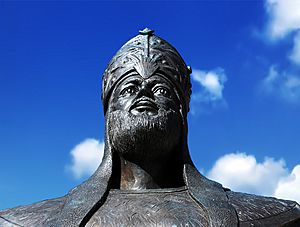
Almanzor died on August 9, 1002, at about 65 years old, in Medinaceli. Before he died, he put his son, Abd al-Malik al-Muzaffar, in charge. His son quickly went to Córdoba after his death to take his father's place.
Almanzor was buried in the courtyard of his palace. His body was covered with a linen cloth woven by his daughters. The cloth was made from materials from his family's land. His tomb was covered with dust that his servants had shaken from their clothes after each battle against the Christians.
Almanzor's family continued to rule through his son Abd al-Malik al-Muzaffar. Then his other son, Abd al-Rahman Sanchuelo, took over. But he couldn't keep the power and was killed in 1009. The fall of Almanzor's family led to the Fitna of al-Andalus, a civil war. This war broke the Caliphate into many smaller kingdoms called taifas.
Later, a legend appeared about a defeat Almanzor suffered just before his death at the Battle of Calatañazor. This story is not true. The saying "in Calatañazor Almanzor lost the drum" means he lost his joy because of a supposed defeat there.
See also
 In Spanish: Almanzor para niños
In Spanish: Almanzor para niños


